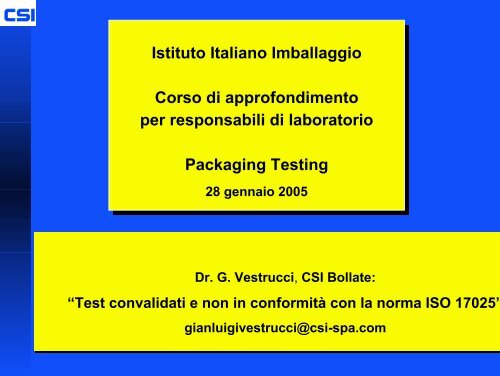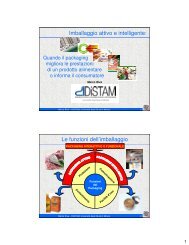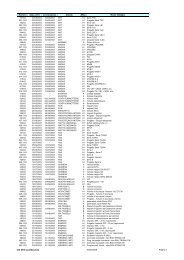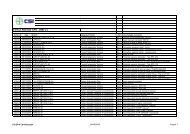Test convalidati e non in conformità con la norma ISO 17025 - Csi
Test convalidati e non in conformità con la norma ISO 17025 - Csi
Test convalidati e non in conformità con la norma ISO 17025 - Csi
You also want an ePaper? Increase the reach of your titles
YUMPU automatically turns print PDFs into web optimized ePapers that Google loves.
Istituto Italiano Imbal<strong>la</strong>ggio<br />
Corso di di approfondimento<br />
per responsabili di di <strong>la</strong>boratorio<br />
Packag<strong>in</strong>g <strong>Test</strong><strong>in</strong>g<br />
28 28 gennaio 2005<br />
2005<br />
Dr. G. Vestrucci, CSI Bol<strong>la</strong>te:<br />
“<strong>Test</strong> <strong><strong>con</strong>validati</strong> e <strong>non</strong> <strong>in</strong> <strong><strong>con</strong>formità</strong> <strong>con</strong> <strong>la</strong> <strong>norma</strong> <strong>ISO</strong> <strong>17025</strong>”<br />
gianluigivestrucci@csi-spa.com
Il percorso tecnico, organizzativo e documentale del<strong>la</strong> Divisio<br />
Food, Packag<strong>in</strong>g & Materials di CSI per eseguire tutti i <strong>con</strong>tro<br />
sugli imbal<strong>la</strong>ggi primari per alimenti <strong>in</strong> <strong><strong>con</strong>formità</strong> <strong>con</strong> <strong>la</strong> norm<br />
<strong>ISO</strong> <strong>17025</strong><br />
Dr. G. Vestrucci, CSI Bol<strong>la</strong>te:<br />
“<strong>Test</strong> <strong><strong>con</strong>validati</strong> e <strong>non</strong> <strong>in</strong> <strong><strong>con</strong>formità</strong> <strong>con</strong> <strong>la</strong> <strong>norma</strong> <strong>ISO</strong> <strong>17025</strong>”
Raggiungere questo obiettivo significa trasformarsi<br />
da tecnico (scienziato?), onnisciente e creativo, artista dei metod<br />
delle analisi<br />
a esecutore - archivista - <strong>con</strong>trollore attento, preciso, discipl<strong>in</strong>a<br />
metodico<br />
Dr. G. Vestrucci, CSI Bol<strong>la</strong>te:<br />
“<strong>Test</strong> <strong><strong>con</strong>validati</strong> e <strong>non</strong> <strong>in</strong> <strong><strong>con</strong>formità</strong> <strong>con</strong> <strong>la</strong> <strong>norma</strong> <strong>ISO</strong> <strong>17025</strong>”<br />
sempre disponibile a dare evidenza dei risultati ottenuti e del <strong>con</strong>trollo<br />
effettuato, sempre, per tutte le variabili del processo analitico. analitico
Dr. G. Vestrucci, CSI Bol<strong>la</strong>te:<br />
“<strong>Test</strong> <strong><strong>con</strong>validati</strong> e <strong>non</strong> <strong>in</strong> <strong><strong>con</strong>formità</strong> <strong>con</strong> <strong>la</strong> <strong>norma</strong> <strong>ISO</strong> <strong>17025</strong>”<br />
Il mantenimento dell’accreditamento SINAL (n° 006), fondamentale per<br />
ns. attività e per il ns. costante miglioramento, ci ha costretto<br />
modificare tutta <strong>la</strong> ns. operatività e documentazione tecnica re<strong>la</strong>tivamen<br />
alle prove e ai <strong>con</strong>trolli che quotidianamente svolgiamo per <strong>la</strong> verifi verif<br />
del<strong>la</strong> <strong><strong>con</strong>formità</strong> degli imbal<strong>la</strong>ggi per alimenti <strong>in</strong> materia p<strong>la</strong>stica.<br />
Le modifiche più significative riguardano:
La scelta dei metodi di prova (ufficiali)<br />
<strong>la</strong> taratura e il <strong>con</strong>trollo del corretto funzionamento di tutta <strong>la</strong> cate<br />
metrologica co<strong>in</strong>volta nel<strong>la</strong> misura<br />
<strong>la</strong> riferibilità delle misure<br />
il campionamento<br />
Dr. G. Vestrucci, CSI Bol<strong>la</strong>te:<br />
“<strong>Test</strong> <strong><strong>con</strong>validati</strong> e <strong>non</strong> <strong>in</strong> <strong><strong>con</strong>formità</strong> <strong>con</strong> <strong>la</strong> <strong>norma</strong> <strong>ISO</strong> <strong>17025</strong>”<br />
<strong>la</strong> manipo<strong>la</strong>zione dei campioni da provare<br />
<strong>la</strong> valutazione dell’<strong>in</strong>certezza di misura dell’<strong>in</strong>tero processo analitico
Dr. G. Vestrucci, CSI Bol<strong>la</strong>te:<br />
“<strong>Test</strong> <strong><strong>con</strong>validati</strong> e <strong>non</strong> <strong>in</strong> <strong><strong>con</strong>formità</strong> <strong>con</strong> <strong>la</strong> <strong>norma</strong> <strong>ISO</strong> <strong>17025</strong>”<br />
Norma UNI CEI EN <strong>ISO</strong>/IEC <strong>17025</strong>:2000<br />
Requisiti generali per <strong>la</strong> competenza dei <strong>la</strong>boratori di<br />
prova e di taratura
Dr. G. Vestrucci, CSI Bol<strong>la</strong>te:<br />
“<strong>Test</strong> <strong><strong>con</strong>validati</strong> e <strong>non</strong> <strong>in</strong> <strong><strong>con</strong>formità</strong> <strong>con</strong> <strong>la</strong> <strong>norma</strong> <strong>ISO</strong> <strong>17025</strong>”<br />
Metodi di prova e taratura e metodi di validazione<br />
Il <strong>la</strong>boratorio deve adottare metodi e procedure appropriati per tutte le prov<br />
e/o tarature nell'ambito del campo di applicazione delle sue attività.<br />
Questi <strong>in</strong>cludono il campionamento, <strong>la</strong> manipo<strong>la</strong>zione, il trasporto<br />
l'immagazz<strong>in</strong>amento e <strong>la</strong> preparazione degli oggetti da provare e/o da tarare,<br />
quando appropriato, una stima del<strong>la</strong> misura dell'<strong>in</strong>certezza come pure<br />
tecniche statistiche per l'analisi dei dati di prova e/o taratura.
Dr. G. Vestrucci, CSI Bol<strong>la</strong>te:<br />
“<strong>Test</strong> <strong><strong>con</strong>validati</strong> e <strong>non</strong> <strong>in</strong> <strong><strong>con</strong>formità</strong> <strong>con</strong> <strong>la</strong> <strong>norma</strong> <strong>ISO</strong> <strong>17025</strong>”<br />
La scelta strategica di CSI è stata di utilizzare sempre e<br />
so<strong>la</strong>mente, per le prove accreditate o di partico<strong>la</strong>re criticità,<br />
norme tecniche dando <strong>la</strong> priorità alle EN, seguite qu<strong>in</strong>di dalle <strong>ISO</strong>,<br />
dalle ASTM, dalle UNI, e via via verso altri enti <strong>norma</strong>tori e<br />
legiferanti (AFNOR, BSI, DIN, EU, ECE, ONU, EPA, FDA, ecc.).<br />
In questo <strong>con</strong>testo <strong>non</strong> è necessaria <strong>la</strong> validazione attuale e<br />
costante del metodo di prova.<br />
La scelta dei metodi di prova<br />
Nelle slides seguenti è riportata una s<strong>in</strong>tesi dei metodi di prova<br />
re<strong>la</strong>tivi alle prove di migrazione globale e specifica.
Norma n° Parte Titolo Da<br />
EN 1186 1<br />
EN 1186 2<br />
EN 1186 3<br />
EN 1186 4<br />
EN 1186 5<br />
EN 1186 6<br />
EN 1186 7<br />
EN 1186 8<br />
EN 1186 9<br />
Dr. G. Vestrucci, CSI Bol<strong>la</strong>te:<br />
“<strong>Test</strong> <strong><strong>con</strong>validati</strong> e <strong>non</strong> <strong>in</strong> <strong><strong>con</strong>formità</strong> <strong>con</strong> <strong>la</strong> <strong>norma</strong> <strong>ISO</strong> <strong>17025</strong>”<br />
ARCHIVIO norme UNI EN <strong>ISO</strong> CEN CEI IEC UL<br />
agg. al 06.06.2004<br />
Materials and articles <strong>in</strong> <strong>con</strong>tact with foodstuffs - P<strong>la</strong>stics - Part 1: Guide<br />
to the selection of <strong>con</strong>ditions and test method for overall migration<br />
Materials and articles <strong>in</strong> <strong>con</strong>tact with foodstuffs - P<strong>la</strong>stics - Part 2: <strong>Test</strong><br />
methods for overall migration <strong>in</strong>to olive oil by total immersion<br />
Materials and articles <strong>in</strong> <strong>con</strong>tact with foodstuffs - P<strong>la</strong>stics - Part 3: <strong>Test</strong><br />
methods for overall migration <strong>in</strong>to acqueous food simu<strong>la</strong>nts by total<br />
immersion<br />
Materials and articles <strong>in</strong> <strong>con</strong>tact with foodstuffs - P<strong>la</strong>stics - Part 4: <strong>Test</strong><br />
methods for overall migration <strong>in</strong>to olive oil by cell<br />
Materials and articles <strong>in</strong> <strong>con</strong>tact with foodstuffs - P<strong>la</strong>stics - Part 5: <strong>Test</strong><br />
methods for overall migration <strong>in</strong>to acqueous food simu<strong>la</strong>nts by cell<br />
Materials and articles <strong>in</strong> <strong>con</strong>tact with foodstuffs - P<strong>la</strong>stics - Part 6: <strong>Test</strong><br />
methods for overall migration <strong>in</strong>to olive oil us<strong>in</strong>g a pouch<br />
Materials and articles <strong>in</strong> <strong>con</strong>tact with foodstuffs - P<strong>la</strong>stics - Part 7: <strong>Test</strong><br />
methods for overall migration <strong>in</strong>to acqueous food simu<strong>la</strong>nts us<strong>in</strong>g a pouch<br />
Materials and articles <strong>in</strong> <strong>con</strong>tact with foodstuffs - P<strong>la</strong>stics - Part 8: <strong>Test</strong><br />
methods for overall migration <strong>in</strong>to olive oil by article fill<strong>in</strong>g<br />
Materials and articles <strong>in</strong> <strong>con</strong>tact with foodstuffs - P<strong>la</strong>stics - Part 9: <strong>Test</strong><br />
methods for overall migration <strong>in</strong>to acqueous food simu<strong>la</strong>nts by article<br />
fill<strong>in</strong>g<br />
200<br />
200<br />
200<br />
200<br />
200<br />
200<br />
200<br />
200<br />
200
Norma n° Parte Titolo Dat<br />
EN 1186 10<br />
EN 1186 11<br />
EN 1186 12<br />
EN 1186 13<br />
EN 1186 14<br />
EN 1186 15<br />
Dr. G. Vestrucci, CSI Bol<strong>la</strong>te:<br />
“<strong>Test</strong> <strong><strong>con</strong>validati</strong> e <strong>non</strong> <strong>in</strong> <strong><strong>con</strong>formità</strong> <strong>con</strong> <strong>la</strong> <strong>norma</strong> <strong>ISO</strong> <strong>17025</strong>”<br />
ARCHIVIO norme UNI EN <strong>ISO</strong> CEN CEI IEC UL<br />
agg. al 25 gennaio 2005<br />
Materials and articles <strong>in</strong> <strong>con</strong>tact with foodstuffs - P<strong>la</strong>stics - Part 10: <strong>Test</strong><br />
methods for overall migration <strong>in</strong>to olive oil (modified method for use <strong>in</strong><br />
cases where <strong>in</strong>complete extraction of olive oil occurs)<br />
Materials and articles <strong>in</strong> <strong>con</strong>tact with foodstuffs - P<strong>la</strong>stics - Part 11: <strong>Test</strong><br />
methods for overall migration <strong>in</strong>to mixture of C-<strong>la</strong>belled sybtetic<br />
triglycerides<br />
Materials and articles <strong>in</strong> <strong>con</strong>tact with foodstuffs - P<strong>la</strong>stics - Part 12: <strong>Test</strong><br />
methods for overall migration at low temperatures<br />
Materials and articles <strong>in</strong> <strong>con</strong>tact with foodstuffs - P<strong>la</strong>stics - Part 13: <strong>Test</strong><br />
methods for overall migration at high temperatures<br />
Materials and articles <strong>in</strong> <strong>con</strong>tact with foodstuffs - P<strong>la</strong>stics - Part 14: <strong>Test</strong><br />
methods for 'substitute test' for overall migration from p<strong>la</strong>stics <strong>in</strong>tended<br />
to come <strong>in</strong>to <strong>con</strong>tact with fatty foodstuffs us<strong>in</strong>g test media iso-octane<br />
and 95% ethanol<br />
Materials and articles <strong>in</strong> <strong>con</strong>tact with foodstuffs - P<strong>la</strong>stics - Part 15:<br />
Alternative test methods to migration <strong>in</strong>to fatty food simu<strong>la</strong>nts by rapid<br />
extraction <strong>in</strong>to iso-octane and/or 95% ethanol<br />
200<br />
200<br />
200<br />
200<br />
200<br />
200
Norma n° Parte Titolo Data<br />
UNI EN 13130 1<br />
UNI EN 13130 2<br />
UNI EN 13130 3<br />
UNI EN 13130 4<br />
UNI EN 13130 5<br />
UNI EN 13130 6<br />
UNI EN 13130 7<br />
UNI EN 13130 8<br />
Dr. G. Vestrucci, CSI Bol<strong>la</strong>te:<br />
“<strong>Test</strong> <strong><strong>con</strong>validati</strong> e <strong>non</strong> <strong>in</strong> <strong><strong>con</strong>formità</strong> <strong>con</strong> <strong>la</strong> <strong>norma</strong> <strong>ISO</strong> <strong>17025</strong>”<br />
ARCHIVIO norme UNI EN <strong>ISO</strong> CEN CEI IEC UL<br />
agg. al 25 gennaio 2005<br />
Materiali ed articoli <strong>in</strong> <strong>con</strong>tatto <strong>con</strong> gli alimenti-Sostanze delle materie<br />
p<strong>la</strong>stiche soggette a limiti-Guida ai metodi di prova per <strong>la</strong> migrazione<br />
specifica di sostanze dalle materie p<strong>la</strong>stiche agli alimenti e simu<strong>la</strong>nti<br />
alimentari e <strong>la</strong> determ<strong>in</strong>azione di sost<br />
Materiali ed articoli <strong>in</strong> <strong>con</strong>tatto <strong>con</strong> gli alimenti-Sostanze delle materie<br />
p<strong>la</strong>stiche soggette a limiti-Determ<strong>in</strong>azione dell'acido tereftalico <strong>in</strong><br />
simu<strong>la</strong>nti alimentari<br />
Materiali ed articoli <strong>in</strong> <strong>con</strong>tatto <strong>con</strong> gli alimenti - -Sostanze delle materie<br />
p<strong>la</strong>stiche soggette a limiti - Determ<strong>in</strong>azione dell'acrilonitrile <strong>in</strong> alimenti e<br />
simu<strong>la</strong>nti alimentari<br />
Materiali ed articoli <strong>in</strong> <strong>con</strong>tatto <strong>con</strong> gli alimenti - -Sostanze delle materie<br />
p<strong>la</strong>stiche soggette a limiti - Determ<strong>in</strong>azione del'1,3-butadiene nelle<br />
materie p<strong>la</strong>stiche<br />
Materiali ed articoli <strong>in</strong> <strong>con</strong>tatto <strong>con</strong> gli alimenti - Sostanze delle materie<br />
p<strong>la</strong>stiche soggette a limiti - Determ<strong>in</strong>azione del cloruro di v<strong>in</strong>ilidene <strong>in</strong><br />
simu<strong>la</strong>nti alimentari<br />
Materiali ed articoli <strong>in</strong> <strong>con</strong>tatto <strong>con</strong> gli alimenti - Sostanze delle materie<br />
p<strong>la</strong>stiche soggette a limiti - Determ<strong>in</strong>azione del cloruro di v<strong>in</strong>ilidene nelle<br />
materie p<strong>la</strong>stiche<br />
Materiali ed articoli <strong>in</strong> <strong>con</strong>tatto <strong>con</strong> gli alimenti - Sostanze delle materie<br />
p<strong>la</strong>stiche soggette a limiti - Determ<strong>in</strong>azione del glicole monoetilenico e<br />
glicole dietilenico <strong>in</strong> simu<strong>la</strong>nti alimentari<br />
Materiali ed articoli <strong>in</strong> <strong>con</strong>tatto <strong>con</strong> gli alimenti - Sostanze delle materie<br />
p<strong>la</strong>stiche soggette a limiti - Determ<strong>in</strong>azione degli isocianati nelle<br />
materie p<strong>la</strong>stiche<br />
2005<br />
2005<br />
2005<br />
2005<br />
2005<br />
2005<br />
2005<br />
2005
Dr. G. Vestrucci, CSI Bol<strong>la</strong>te:<br />
“<strong>Test</strong> <strong><strong>con</strong>validati</strong> e <strong>non</strong> <strong>in</strong> <strong><strong>con</strong>formità</strong> <strong>con</strong> <strong>la</strong> <strong>norma</strong> <strong>ISO</strong> <strong>17025</strong>”<br />
Apparecchiature<br />
Le apparecchiature devono essere utilizzate da personale autorizzato.<br />
Istruzioni aggiornate sull'utilizzo e manutenzione (compreso ogni re<strong>la</strong>tivo<br />
manuale fornito dal costruttore delle apparecchiature) devono essere<br />
facilmente disponibili dal personale appropriato del <strong>la</strong>boratorio.<br />
Ogni elemento di un'apparecchiatura ed il software utilizzato per le prove e<br />
le tarature e significativo per i risultati, deve, quando possibile, essere<br />
univocamente identificato.<br />
Devono essere mantenute le registrazioni per ogni elemento delle<br />
apparecchiature e del suo software che sono significativi per le prove e/o<br />
tarature eseguite.
Dr. G. Vestrucci, CSI Bol<strong>la</strong>te:<br />
“<strong>Test</strong> <strong><strong>con</strong>validati</strong> e <strong>non</strong> <strong>in</strong> <strong><strong>con</strong>formità</strong> <strong>con</strong> <strong>la</strong> <strong>norma</strong> <strong>ISO</strong> <strong>17025</strong>”<br />
Apparecchiature<br />
Il <strong>la</strong>boratorio deve essere dotato di tutte le attrezzature per il campionamento,<br />
per le misure e per le prove per una corretta esecuzione delle prove e/o delle<br />
tarature.<br />
…………..<br />
Le apparecchiature ed il software utilizzato per le prove, le tarature ed il<br />
campionamento deve permettere l'accuratezza richiesta e deve essere <strong>con</strong>forme<br />
alle specifiche re<strong>la</strong>tive alle prove e/o tarature.<br />
Devono essere stabiliti programmi di taratura per le grandezze o i valori<br />
essenziali degli strumenti quando queste proprietà hanno un effetto significativo<br />
sui risultati.<br />
Prima di essere poste <strong>in</strong> servizio le apparecchiature (compresa quel<strong>la</strong> utilizzata<br />
per <strong>la</strong> taratura) devono essere tarate o <strong>con</strong>trol<strong>la</strong>te per stabilire che soddisf<strong>in</strong>o le<br />
specifiche del <strong>la</strong>boratorio e siano <strong>con</strong>formi alle specifiche delle re<strong>la</strong>tive norme.<br />
Questo deve essere <strong>con</strong>trol<strong>la</strong>to e/o tarato prima dell'utilizzo.
Dr. G. Vestrucci, CSI Bol<strong>la</strong>te:<br />
“<strong>Test</strong> <strong><strong>con</strong>validati</strong> e <strong>non</strong> <strong>in</strong> <strong><strong>con</strong>formità</strong> <strong>con</strong> <strong>la</strong> <strong>norma</strong> <strong>ISO</strong> <strong>17025</strong>”<br />
Riferibilità delle misure<br />
Tutte le apparecchiature usate per le prove e /o tarature, comprese le<br />
apparecchiature per misure ausiliarie (per esempio per le <strong>con</strong>dizioni<br />
ambientali) che hanno un'<strong>in</strong>fluenza significativa sull'accuratezza o sul<strong>la</strong><br />
validità del risultato di prova , di taratura o campionamento devono essere<br />
tarate prima di essere messe <strong>in</strong> servizio. Il <strong>la</strong>boratorio deve stabilire un<br />
programma ed una procedura per <strong>la</strong> taratura delle proprie<br />
apparecchiature.<br />
Tale programma dovrebbe comprendere un sistema per selezionare,<br />
utilizzare, tarare, verificare, <strong>con</strong>trol<strong>la</strong>re e mantenere i campioni di misura<br />
ed i materiali di riferimento, così come le apparecchiature impiegate per<br />
eseguire le prove e le tarature.
Dr. G. Vestrucci, CSI Bol<strong>la</strong>te:<br />
“<strong>Test</strong> <strong><strong>con</strong>validati</strong> e <strong>non</strong> <strong>in</strong> <strong><strong>con</strong>formità</strong> <strong>con</strong> <strong>la</strong> <strong>norma</strong> <strong>ISO</strong> <strong>17025</strong>”<br />
Campioni di riferimento e materiali di riferimento<br />
Campioni di riferimento<br />
Il <strong>la</strong>boratorio deve avere un programma e una procedura per <strong>la</strong> taratura<br />
dei propri campioni di riferimento. I campioni di riferimento devono essere<br />
tarati da un organismo che sia <strong>in</strong> grado di fornire <strong>la</strong> riferibilità.<br />
Tali campioni di riferimento di misura <strong>con</strong>servati dal <strong>la</strong>boratorio devono<br />
essere utilizzati soltanto per <strong>la</strong> taratura e <strong>non</strong> per altri scopi, salvo che sia<br />
possibile dimostrare che <strong>non</strong> siano <strong>in</strong>validate le prestazioni come campioni<br />
di riferimento. I campioni di riferimento devono essere tarati prima e dopo<br />
ogni rego<strong>la</strong>zione.<br />
Materiali di riferimento<br />
Quando possibile i materiali di riferimento devono essere riferibili alle<br />
unità SI di misura, o a materiali di riferimento certificati. I materiali di<br />
riferimento <strong>in</strong>terni devono essere <strong>con</strong>trol<strong>la</strong>ti nel<strong>la</strong> misura <strong>in</strong> cui sia<br />
tecnicamente ed e<strong>con</strong>omicamente fattibile.
Dr. G. Vestrucci, CSI Bol<strong>la</strong>te:<br />
“<strong>Test</strong> <strong><strong>con</strong>validati</strong> e <strong>non</strong> <strong>in</strong> <strong><strong>con</strong>formità</strong> <strong>con</strong> <strong>la</strong> <strong>norma</strong> <strong>ISO</strong> <strong>17025</strong>”<br />
Stima dell'<strong>in</strong>certezza di misura<br />
Un <strong>la</strong>boratorio di prova che esegue <strong>in</strong> proprio le tarature, deve avere e deve<br />
applicare una procedura per stimare l'<strong>in</strong>certezza del<strong>la</strong> misura per tutte le<br />
tarature e per i tipi di taratura deve avere e deve applicare una procedura<br />
per stimare l'<strong>in</strong>certezza del<strong>la</strong> misura<br />
I <strong>la</strong>boratori di prova devono avere e devono applicare procedure per stimare<br />
l'<strong>in</strong>certezza delle misure. In certi casi <strong>la</strong> natura dei metodi di prova può<br />
escludere il calcolo dell'<strong>in</strong>certezza di misura rigoroso e valido dal punto di<br />
vista metrologico e statistico. In questi casi il <strong>la</strong>boratorio deve almeno<br />
tentare di identificare tutte le componenti che hanno <strong>in</strong>fluenza<br />
sull'<strong>in</strong>certezza e fare una stima ragionevole, e deve garantire che<br />
l'espressione del risultato <strong>non</strong> fornisca un'impressione errata dell'<strong>in</strong>certezza.<br />
Una stima ragionevole deve essere basata sul<strong>la</strong> <strong>con</strong>oscenza del metodo e sul<br />
campo del<strong>la</strong> misura e deve far uso, per esempio, delle esperienze precedenti<br />
e del<strong>la</strong> validazione dei dati.<br />
Quando si stima l'<strong>in</strong>certezza di misura, dovranno essere prese <strong>in</strong><br />
<strong>con</strong>siderazione, utilizzando appropriati metodi di analisi, tutte le<br />
componenti dell'<strong>in</strong>certezza che sono di rilievo <strong>in</strong> una data situazione.
Dr. G. Vestrucci, CSI Bol<strong>la</strong>te:<br />
“<strong>Test</strong> <strong><strong>con</strong>validati</strong> e <strong>non</strong> <strong>in</strong> <strong><strong>con</strong>formità</strong> <strong>con</strong> <strong>la</strong> <strong>norma</strong> <strong>ISO</strong> <strong>17025</strong>”<br />
Il grado di <strong>con</strong>tributo di tali fattori sull’<strong>in</strong>certezza totale, differisc<br />
notevolmente da prova a prova (o fra i tipi di prova) e fra taratura e taratura (<br />
fra tipi di taratura). Il <strong>la</strong>boratorio deve prendere <strong>in</strong> <strong>con</strong>siderazione questi fattor<br />
nello sviluppare i metodi e le procedure di prova e taratura, nell’addestrament<br />
e nel<strong>la</strong> qualifica del personale, e nel<strong>la</strong> scelta e nel<strong>la</strong> taratura dell<br />
apparecchiature da usare.
Controllo dei dati<br />
Dr. G. Vestrucci, CSI Bol<strong>la</strong>te:<br />
“<strong>Test</strong> <strong><strong>con</strong>validati</strong> e <strong>non</strong> <strong>in</strong> <strong><strong>con</strong>formità</strong> <strong>con</strong> <strong>la</strong> <strong>norma</strong> <strong>ISO</strong> <strong>17025</strong>”<br />
I calcoli ed il trasferimento dei dati devono essere soggetti a <strong>con</strong>trolli appropriati<br />
<strong>con</strong>dotti <strong>in</strong> modo sistematico.<br />
Quando vengono utilizzati e<strong>la</strong>boratori elettronici od apparecchiature automatiche<br />
per l'acquisizione, il trattamento, <strong>la</strong> registrazione, <strong>la</strong> presentazione , <strong>la</strong><br />
<strong>con</strong>servazione o <strong>la</strong> ricerca di dati di prova o di taratura, il <strong>la</strong>boratorio deve<br />
garantire che:<br />
il software dell'e<strong>la</strong>boratore elettronico sviluppato dall'utilizzatore sia<br />
documentato <strong>con</strong> sufficiente dettaglio e sia <strong>con</strong>venientemente validato per<br />
l'adeguatezza all'uso;<br />
le procedure siano preparate ed applicate per proteggere i dati; tali procedure<br />
devono comprendere, ma <strong>non</strong> a carattere limitativo, gli aspetti di <strong>in</strong>tegrità e di<br />
<strong>con</strong>fidenzialità dei dati di <strong>in</strong>gresso o del<strong>la</strong> raccolta dati, del<strong>la</strong> <strong>con</strong>servazione,<br />
del<strong>la</strong> trasmissione e del trattamento degli stessi;
Dr. G. Vestrucci, CSI Bol<strong>la</strong>te:<br />
“<strong>Test</strong> <strong><strong>con</strong>validati</strong> e <strong>non</strong> <strong>in</strong> <strong><strong>con</strong>formità</strong> <strong>con</strong> <strong>la</strong> <strong>norma</strong> <strong>ISO</strong> <strong>17025</strong>”<br />
Assicurazione del<strong>la</strong> qualità dei risultati di prova e taratura<br />
Il <strong>la</strong>boratorio deve avere procedure di <strong>con</strong>trollo qualità per monitorare <strong>la</strong><br />
validità delle prove e o delle tarature eseguite. I dati risultanti devono essere<br />
registrati <strong>in</strong> modo che le l<strong>in</strong>ee di tendenza siano rive<strong>la</strong>bili e, quando sia<br />
fattibile, devono essere applicate tecniche statistiche per riesam<strong>in</strong>are i<br />
risultati. Il monitoraggio deve essere pianificato e riesam<strong>in</strong>ato e può<br />
<strong>in</strong>cludere, a carattere <strong>non</strong> limitativo, quanto segue:<br />
a) l'utilizzo rego<strong>la</strong>re di materiali di riferimento certificati e/o <strong>con</strong>trollo<br />
qualità <strong>in</strong>terno che utilizza materiali di riferimento se<strong>con</strong>dari;<br />
b) <strong>la</strong> partecipazione a programmi di prove <strong>in</strong>ter<strong>la</strong>boratorio o di prove di<br />
attitud<strong>in</strong>e;<br />
c) <strong>la</strong> ripetizione di prove e/o di tarature utilizzando metodi identici o<br />
differenti;<br />
d) l'effettuazione di nuove prove e/o le tarature sugli oggetti <strong>con</strong>servati;<br />
e) <strong>la</strong> corre<strong>la</strong>zione di risultati fra caratteristiche diverse di un oggetto.<br />
NOTA: I metodi selezionati dovrebbero essere appropriati al tipo ed al<br />
volume delle attività svolte.
Dr. G. Vestrucci, CSI Bol<strong>la</strong>te:<br />
“<strong>Test</strong> <strong><strong>con</strong>validati</strong> e <strong>non</strong> <strong>in</strong> <strong><strong>con</strong>formità</strong> <strong>con</strong> <strong>la</strong> <strong>norma</strong> <strong>ISO</strong> <strong>17025</strong>”<br />
In <strong>con</strong>clusione<br />
I <strong>con</strong>trolli <strong>in</strong> <strong><strong>con</strong>formità</strong> <strong>con</strong> <strong>la</strong> <strong>ISO</strong> <strong>17025</strong> richiedono:<br />
<strong>la</strong> <strong>con</strong>oscenza del<strong>la</strong> legis<strong>la</strong>zione e delle norme<br />
un metodo validato (<strong>norma</strong> ufficiale, se esiste)<br />
una strumentazione tarata<br />
materiali di riferimento (certificati)<br />
campioni di riferimento (certificati)<br />
istruzioni di <strong>la</strong>voro dettagliate<br />
uno o più fogli di calcolo validati e protetti da danneggiamenti<br />
accidentali<br />
<strong>la</strong> stima dell’<strong>in</strong>certezza di misura totale<br />
un format del report di analisi (protetto) e coerente <strong>con</strong> il metodo<br />
adottato<br />
un <strong>con</strong>trollo dell’<strong>in</strong>tera procedura<br />
un <strong>con</strong>trollo periodico del<strong>la</strong> qualità dei dati prodotti<br />
l’eventuale commento o giudizio, ma espresso da personale<br />
qualificato
Dr. G. Vestrucci, CSI Bol<strong>la</strong>te:<br />
“<strong>Test</strong> <strong><strong>con</strong>validati</strong> e <strong>non</strong> <strong>in</strong> <strong><strong>con</strong>formità</strong> <strong>con</strong> <strong>la</strong> <strong>norma</strong> <strong>ISO</strong> <strong>17025</strong>”<br />
Un esempio <strong>con</strong>creto:<br />
<strong>la</strong> procedura di prova per <strong>la</strong> determ<strong>in</strong>azione del<strong>la</strong> migrazion<br />
specifica di TPA e EG+DEG da imbal<strong>la</strong>ggi <strong>in</strong> PET
Dr. G. Vestrucci, CSI Bol<strong>la</strong>te:<br />
“<strong>Test</strong> <strong><strong>con</strong>validati</strong> e <strong>non</strong> <strong>in</strong> <strong><strong>con</strong>formità</strong> <strong>con</strong> <strong>la</strong> <strong>norma</strong> <strong>ISO</strong> <strong>17025</strong>”<br />
La Procedura Operativa (POP):<br />
<strong>la</strong> POP CFM003 per <strong>la</strong> determ<strong>in</strong>azione delle migrazioni specifiche di TPA e EG+DEG<br />
da <strong>con</strong>tenitori <strong>in</strong>i PET dest<strong>in</strong>ati al <strong>con</strong>tatto <strong>con</strong> alimenti si artico<strong>la</strong> <strong>in</strong>:<br />
titolo, orig<strong>in</strong>e, <strong>in</strong>dice, scopo e riferimenti <strong>norma</strong>tivi;<br />
il pr<strong>in</strong>cipio del<strong>la</strong> misura;<br />
<strong>la</strong> qualifica del personale;<br />
i dettagli del<strong>la</strong> procedura di prova;<br />
le ulteriori istruzioni di <strong>la</strong>voro;<br />
il calcolo dell’<strong>in</strong>certezza di misura totale;<br />
il foglio di calcolo delle migrazioni (bloccato e protetto);<br />
il format del Rapporto di Prova (protetto).
Dr. G. Vestrucci, CSI Bol<strong>la</strong>te:<br />
“<strong>Test</strong> <strong><strong>con</strong>validati</strong> e <strong>non</strong> <strong>in</strong> <strong><strong>con</strong>formità</strong> <strong>con</strong> <strong>la</strong> <strong>norma</strong> <strong>ISO</strong> <strong>17025</strong>”<br />
Un estratto del foglio di calcolo del<strong>la</strong> migrazione specifica - I parte<br />
FOGLIO DI CALCOLO PER VALUTAZIONE DELLA MIGRAZIONE SPECIFICA DI ACIDO TEREFTALICO IN LIQUIDI<br />
SIMULANTI ACQUOSI PER RIEMPIMENTO DI UN CONTENITORE, SECONDO NORMA UNI ENV 13130-2<br />
Accettazione: xyz/LCF/PKG/04<br />
Data: …………<br />
Cliente: ………..<br />
Contenitore:<br />
vaschetta, bottiglia, f<strong>la</strong><strong>con</strong>e, vasetto<br />
TEST:<br />
Contenitore: bottiglia<br />
Capacità <strong>con</strong>tenitore, ml: 1500<br />
Volume/peso prodotto, mg: 1500<br />
Superficie <strong>in</strong>terna a <strong>con</strong>tatto,<br />
dmq: 7<br />
VARIABILI PROVA DI<br />
CESSIONE<br />
g p q<br />
simu<strong>la</strong>nti acquosi per riempimento<br />
dati del campione<br />
volume simu<strong>la</strong>nte impiegato,<br />
superficie posta a <strong>con</strong>tatto,<br />
ml 1500 dmq:<br />
7<br />
dati di <strong>in</strong>gresso
Dr. G. Vestrucci, CSI Bol<strong>la</strong>te:<br />
“<strong>Test</strong> <strong><strong>con</strong>validati</strong> e <strong>non</strong> <strong>in</strong> <strong><strong>con</strong>formità</strong> <strong>con</strong> <strong>la</strong> <strong>norma</strong> <strong>ISO</strong> <strong>17025</strong>”<br />
Un estratto del foglio di calcolo del<strong>la</strong> migrazione specifica - II parte<br />
CONC.(PPM)<br />
TPA<br />
CONC. (PPM)<br />
TPA SOLUZIO<br />
PER TARATU<br />
data preparazione soluzione madre<br />
<strong>con</strong>c.<br />
(mg/l)<br />
RIFERIMENTO<br />
15/09/03 TPA 542,0 433,60 1<br />
17/09/03 orto-FTALICO 1012,0<br />
altezza<br />
216,80<br />
108,40<br />
altezza picco TPA<br />
picco PA 43,36<br />
STD 5 38322 41599 21,68<br />
STD 4 20925 42414 0,00<br />
STD 3 8905 39731<br />
STD 2 3666 40169<br />
STD 1 1819 38941<br />
STD 0 0 42333<br />
Limite di rilevabilità di TPA : 0.1 ppm pari a 1/10 dell'altezza del picco<br />
del<strong>la</strong> prima soluzione di riferimento di <strong>la</strong>voro.
Dr. G. Vestrucci, CSI Bol<strong>la</strong>te:<br />
“<strong>Test</strong> <strong><strong>con</strong>validati</strong> e <strong>non</strong> <strong>in</strong> <strong><strong>con</strong>formità</strong> <strong>con</strong> <strong>la</strong> <strong>norma</strong> <strong>ISO</strong> <strong>17025</strong>”<br />
Un estratto del foglio di calcolo del<strong>la</strong> migrazione specifica - III parte<br />
Risultati sull'imbal<strong>la</strong>ggio completo:<br />
liq. Simu<strong>la</strong>nte picco TPA/picco PA<br />
ppm da<br />
analisi mg/dmq ppm pkg<br />
1° prov<strong>in</strong>o 0,5 16,4 3,5 24,7<br />
2° prov<strong>in</strong>o 0,3 8,5 1,8 12,8<br />
3° prov<strong>in</strong>o 0,3 4,5 1,0 6,8<br />
media 0,4 9,8 2,1 14,7<br />
limite 1,3 7,5<br />
dev std x2 0,3 12,1 2,6 18,2<br />
tolleranza ±0,2 ±1,1
Rapp. altezze TPA/IPA (u.a.)<br />
Dr. G. Vestrucci, CSI Bol<strong>la</strong>te:<br />
“<strong>Test</strong> <strong><strong>con</strong>validati</strong> e <strong>non</strong> <strong>in</strong> <strong><strong>con</strong>formità</strong> <strong>con</strong> <strong>la</strong> <strong>norma</strong> <strong>ISO</strong> <strong>17025</strong>”<br />
Un requisito str<strong>in</strong>gente: <strong>la</strong> retta di taratura<br />
1,0000<br />
0,9000<br />
0,8000<br />
0,7000<br />
0,6000<br />
0,5000<br />
0,4000<br />
0,3000<br />
0,2000<br />
0,1000<br />
0,0000<br />
GRAFICO DI TARATURA<br />
Retta di taratura:<br />
y = 0,0558 x + 0,0016<br />
R 2 = 0,9985<br />
0,00 2,00 4,00 6,00 8,00 10,00 12,00 14,00 16,00 18,00<br />
Conc. TPA (ppm)
Dr. G. Vestrucci, CSI Bol<strong>la</strong>te:<br />
“<strong>Test</strong> <strong><strong>con</strong>validati</strong> e <strong>non</strong> <strong>in</strong> <strong><strong>con</strong>formità</strong> <strong>con</strong> <strong>la</strong> <strong>norma</strong> <strong>ISO</strong> <strong>17025</strong>”<br />
Un estratto del foglio di calcolo dell’<strong>in</strong>certezza di misura<br />
Simu<strong>la</strong>nti acquosi<br />
Incertezza (j) % (uj%) /100 (uj) (uj 2 *n) RIPETIZ. (n)<br />
INCERTEZZA SULLA PREPARATIVA (vetreria di c<strong>la</strong>sse A)<br />
Purezza del TPA 1 0,01 0,0001<br />
Pesata del TPA 0,2 0,002 0,000004<br />
Diluizione <strong>in</strong> matraccio 0,1 0,001 0,000001<br />
Purezza del PA 1 0,01 0,0001<br />
Pesata di Acido ortoftalico 0,1 0,001 0,000001<br />
… …<br />
SIMULANTE ACQUOSO<br />
… … …<br />
Volume di soluzione di PA prelevato 0,5 0,005 0,000025<br />
Volume di soluzione di TPA prelevato 0,5 0,005 0,000125 5<br />
Volume di acqua prelevato 0,4 0,004 0,00008 5<br />
Volume di liquido simu<strong>la</strong>nte da migrazione 0,5 0,005 0,0001 4<br />
Volume di acqua prelevato 0,4 0,004 0,000064 4<br />
… … … … …<br />
INCERTEZZA SULLO STRUMENTO<br />
Flusso 0,1 0,001 0,000001<br />
Lunghezza d'onda 0,4 0,004 0,000016<br />
Iniettore 0,3 0,003 0,000009<br />
somma 0,001319<br />
INCERTEZZA COMPOSTA radice quadrata 0,036323
CSI<br />
CERTIFICATION of SAFETY INSTITUT<br />
(Gruppo IMQ)<br />
La cultura del<strong>la</strong> ricerca<br />
applicata al test<strong>in</strong>g ed al<strong>la</strong> certificazione







